Canadian employees’ poor mental health – Benefits Canada Healthcare Survey results
By: Benefits by Design | Tuesday October 8, 2024
Updated : Wednesday October 30, 2024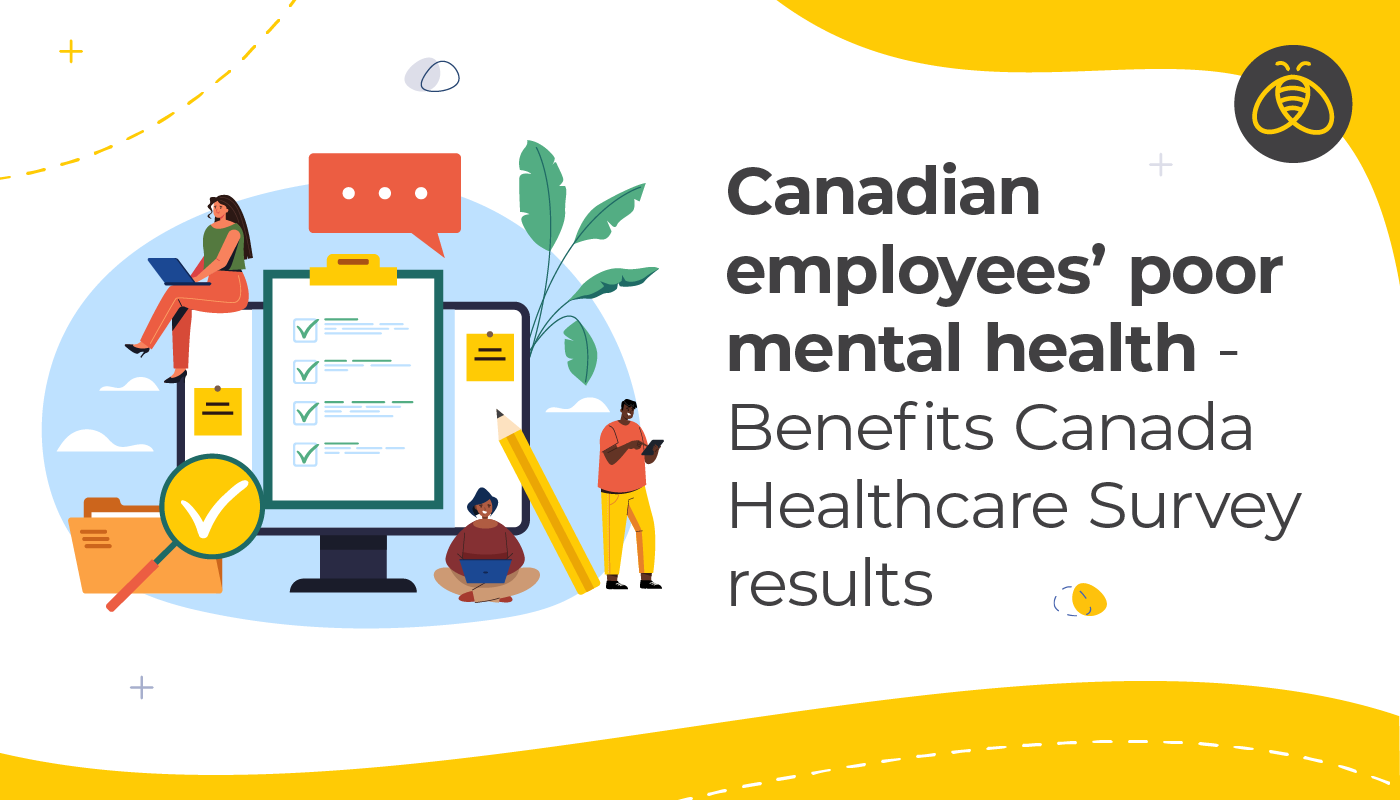
Canadian employees with poor mental health are often exposed to a ripple effect that cannot be ignored. The 2024 Benefits Canada Healthcare Survey (BCHS) focused on whole person health. This is the concept that each pillar of health affects the other, and that when treating any condition, we must look at all aspects of health. Simply treating the symptoms in silos doesn’t address the root cause, or possible comorbidities.
13 Tips to Help Promote Employee Health and Wellbeing – Part 1
13 Tips to Help Promote Employee Health and Wellbeing – Part 2
Key mental health findings
- Employees with poor mental health were more likely to report their overall health as poor (30% more), have increased levels of stress (21% more), and rate their work-life balance as poor (24% more).
- Employees with poor mental experienced more barriers to access (91%), feel their workplace does not support mental wellbeing (53%) and have another chronic condition (80%).
- Employers are providing an average of $1,743 annual maximum for counselling, 41% provide an employee assistance program (EAP), and 55% offer training for managers to help them manage employees dealing with mental health issues.
The mental health of employees
Employee mental health remains a top concern for employers, with many realizing the consequences that poor mental health can have on their workforce. A whopping 40% of employees with poor overall health also reported having poor mental health, compared to the average of just 11% for all employees.
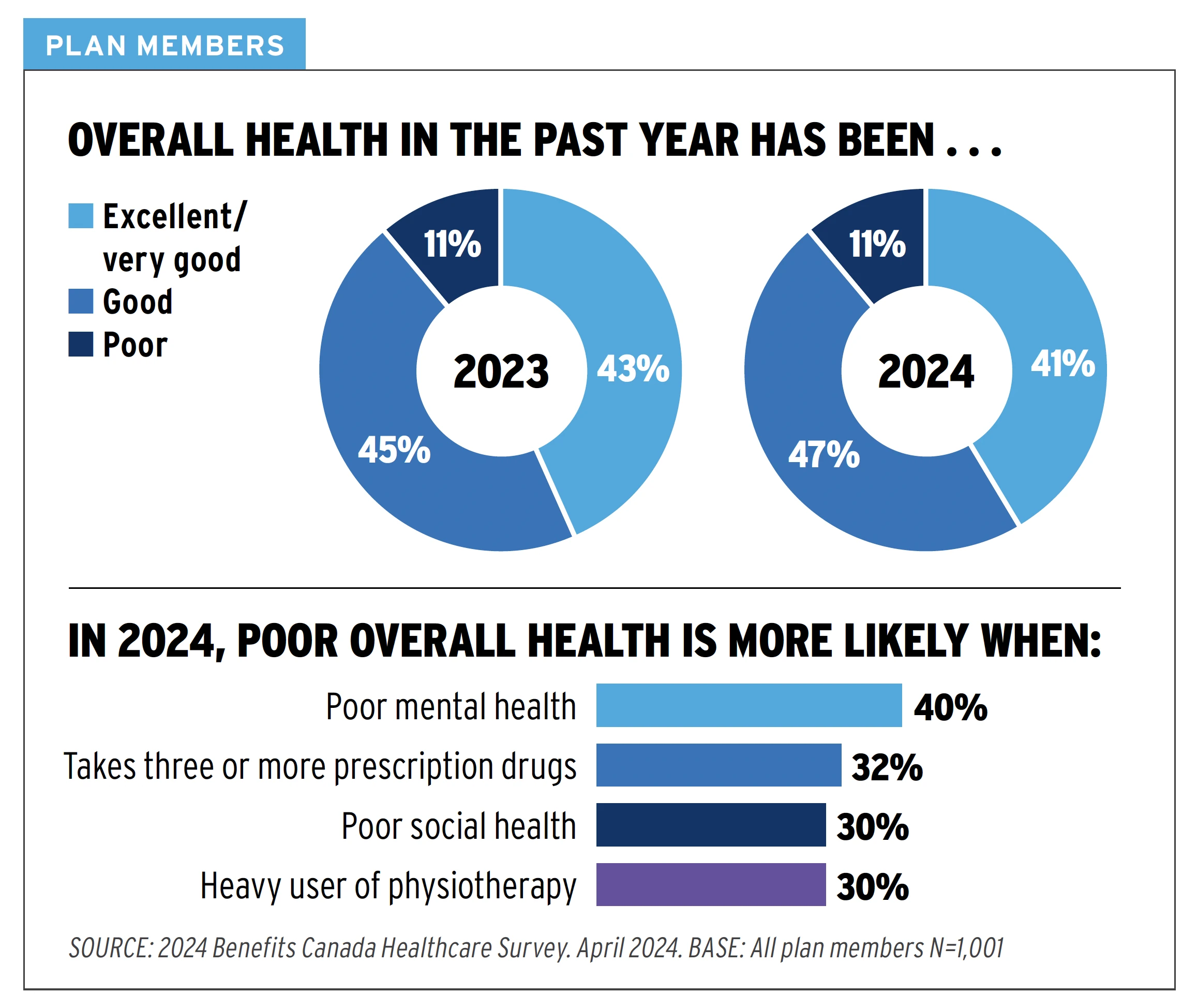
While less than a fifth (17%) of employees reported having poor mental health over the last year, these numbers more than doubled when support was not available, or when members felt disconnected or isolated. Almost half of those experiencing poor social health admitted to having poor mental health. When looked at another way, 76% of those who were lonely also said they have poor mental health. This suggests that having the support of community, friends, and family plays a large role in our mental health.
Stress levels also contribute to mental health issues. “High daily stress increased [from 36%] to 57% among those who reported poor mental health.”
How is poor mental health affecting:
Views on workplace and benefits plan
Three-quarters of employees agree their benefits plan is either excellent or good. However, for those with poor mental health, that number drops to just 60%. Work-life balance also took a hit, with 42% of plan members with poor mental health also rating their work-life balance as poor – compared to 16% overall.
Access to mental health support through benefits plans
“More than half (53%) of those with poor mental health felt their workplace environment doesn’t support mental wellness.” In fact, almost 30% of plan members who were heavy users of the mental health benefits “felt their benefits plan doesn’t meet their needs.”
Aside from feeling unsupported, there are other barriers to accessing mental health support. In fact, 91% of employees with poor mental health cited some form of barrier – suggesting that more can be done to help those suffering with mental health issues. The largest issues preventing care were personal costs (58%), and lack of motivation (48%).
Unsurprisingly, this correlates with the fact that mental health counselling incurred the largest average out-of-pocket expense at $1,207. That amount more than doubled for plan members who were heavy users of the mental health benefits. Unfortunately, members in poor mental health were also the most likely (36%) to discontinue treatment until the new benefits year once their maximums were reached. This provides two insights. Firstly, employees with poor mental health are reaching their benefit maximum more often than other plan members. Secondly, mental health benefit maximums are still not adequate.
Other chronic conditions
Mental health conditions have quickly surpassed all other chronic condition diagnoses. At 22%, they are diagnosed almost twice as much as the next leading conditions, which are high cholesterol and arthritis, both diagnosed at 13%. See image below for more details.
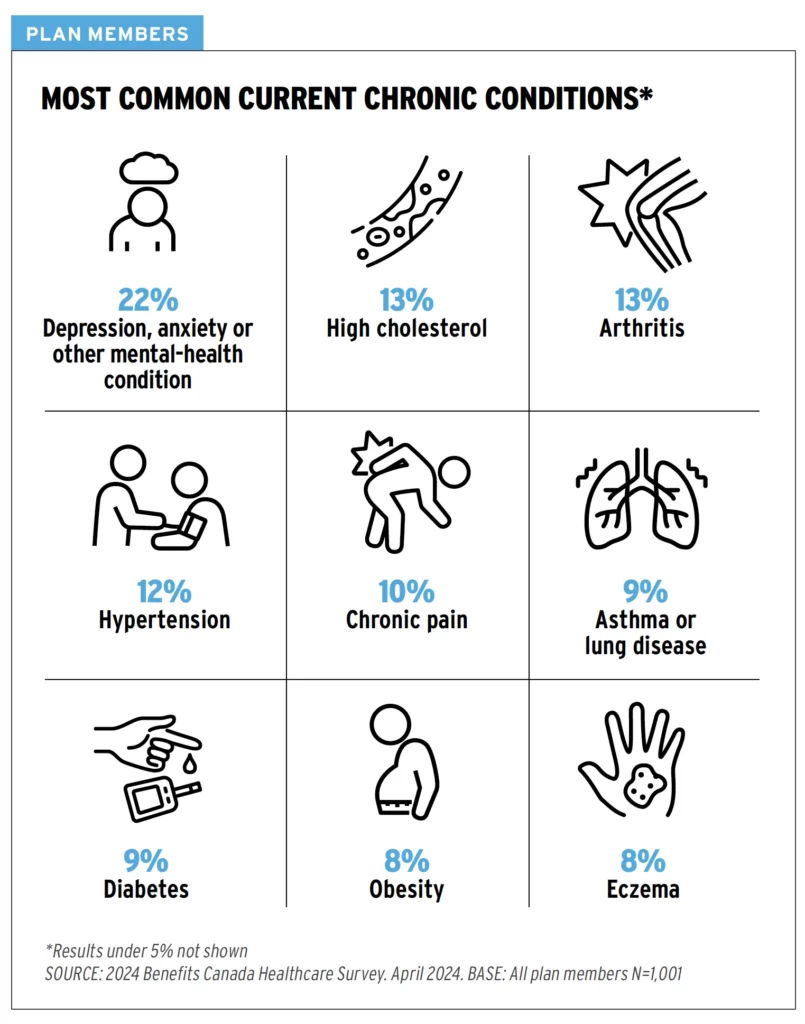
Four in five plan members with poor mental health also reported having a chronic condition. They were also more likely to have experienced a sense of isolation or disconnection from their workplace in the last year (76%).
“We need to remove the stigma and address the comorbidity around chronic pain and mental-health disorders. My patients always tell me, ‘I wouldn’t want anyone to know this is happening to me. My manager and co-workers will roll their eyes, dismiss me or put me on a desk job I don’t want to do.’ These conversations need to happen in a safe environment and are really critical for their health.” – Dr. Ayla Azad, Canadian Chiropractic Association.
How are employees using mental health benefits
Employees want to improve their mental health, despite some of the access issues listed above. According to the survey, their top three treatment options for mental health conditions are physical activity (54%), healthier eating (44%), and counselling (38%).
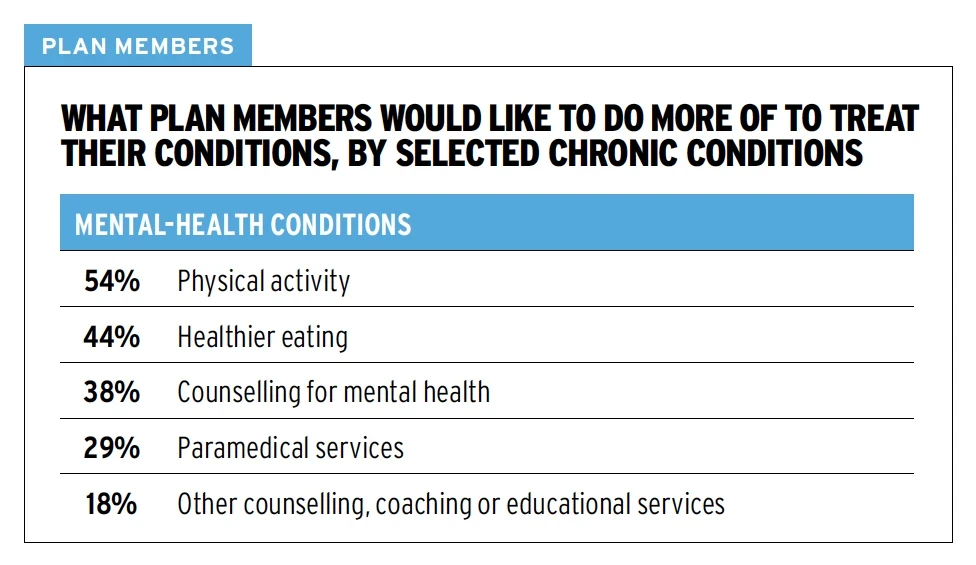
Interestingly, “those with a mental-health condition were much more likely to be heavy users of the drug plan (44%) than of mental-health counselling (14%).”
At the same time, claims for mental health counselling were the second highest category. This suggests that employees are using both counselling and drugs to counteract mental health conditions. Another likely cause for the higher drug use is the higher percentage of comorbidities experienced by plan members with poor mental health. Therefore, the increased drug use could be to treat other conditions.
But while usage for mental health benefits is high, the stigma still remains. This is underscored by the fact that employees were more willing to cut back on mental health counselling (30%) than any other benefit, to receive coverage for a preferred benefit.
How are employers helping?
Employers are responding to the need for mental health support. Partly because it’s the right thing to do, and partly because the data is showing that improved mental health means improved business outcomes. In fact, two of every five employers have plans to improve or increase mental health benefits.
Mental health coverage
While that may not seem like a lot, in reality, many already offer mental health coverage. An employee assistance program (EAP – 41%)) tops the list for mental health counselling services, followed by paramedical services (33%) and a health care spending account (HCSA – 289%). See image below:
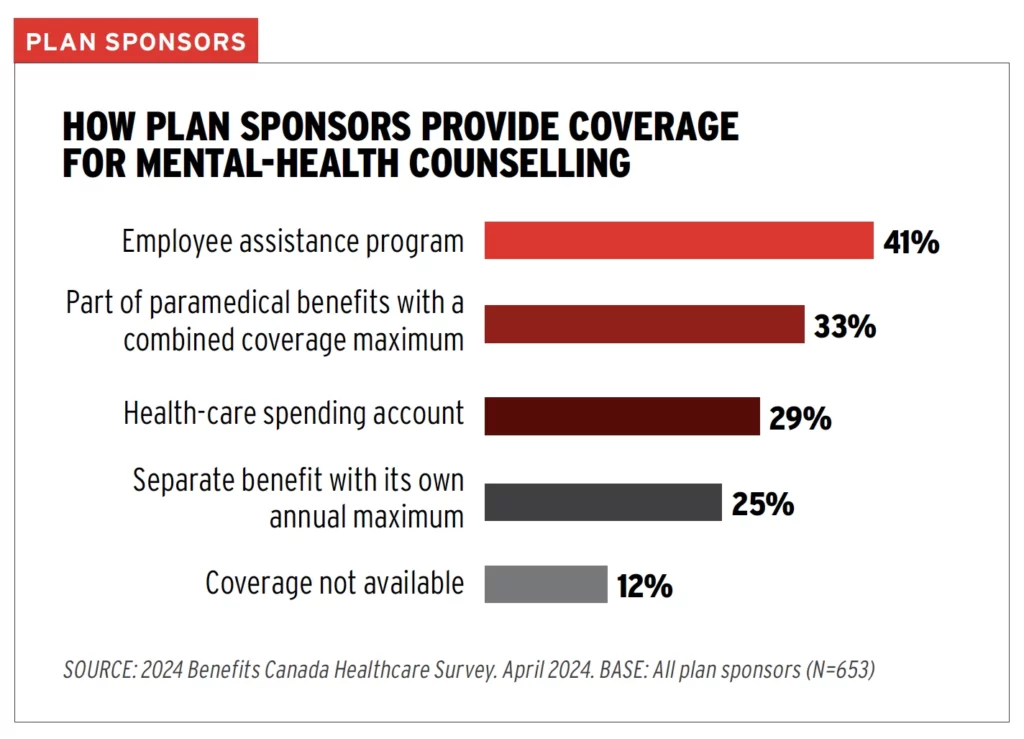
When offered separately, the average annual maximum for counselling was $1,743, which is actually down by about $80 from last year.
The table below shows the percentage of groups offering different tiers of coverage.

The majority of employers are trying to help improve employee wellness, and the largest area of focus is on mental health and wellbeing. However, this doesn’t necessarily come in the form of employee benefits. Indeed, 44% of the 79% of employees who plan to invest outside employee benefits want to spend that money in the area of emotional or mental health.
Financial wellness
When speaking about poor mental health, one cannot ignore the mental toll that poor financial wellbeing is having on Canadians’ emotional health.
“Financial health appearing low on the list of plan sponsor priorities is surprising. Some respondents
may consider the need addressed because of programs in place. The data shows similar elevated daily stress levels when comparing those reporting poor financial health to poor mental health. We
should not lose sight of the member lens which has consistently shown financial health as a prominent stress point.” – Shannon Darvill, People Corporation.
To Shannon’s point, financial health support is only available at 18% of organizations, and only 24% plan to invest in this category in the future. With cost being a barrier to care, and finances being the number one stressor for Canadians, it could be prudent for businesses to elevate the priority of this wellness pillar.
Training for managers
Lastly, many companies are providing mental health training for managers. We applaud these efforts, since handling mental health issues could cause anxiety to the manager as well. Which in turn worsens the overall mental health of your workplace. The image below shows that only 32% of companies do not offer any mental health training for management, while 55% of them do.

Overall, poor mental health plays a major role in how employees view their benefits plans, how they cope with isolation and stress, and what other conditions might be affecting them. What’s clear is that treatment plans could be more effective if they look at the whole health of a patient.


